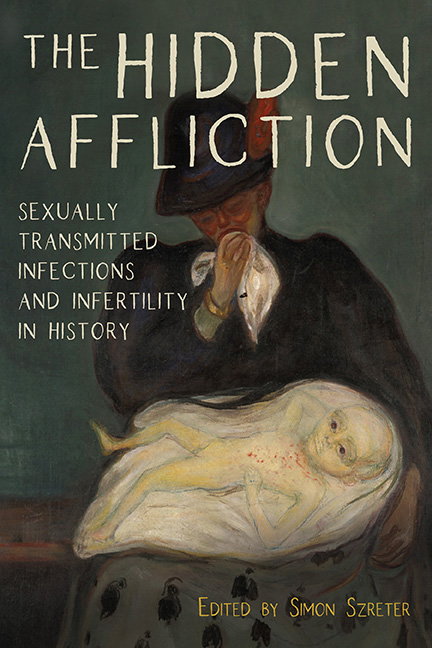Book contents
- Frontmatter
- Contents
- Acknowledgments
- Introduction
- Part One The Hidden Pitfalls in the Early Documentary Record
- Part Two The Biomedical Sciences and the History of the STI Microorganisms
- Part Three Population Decline in the Global South
- Part Four Infertility and the Specter of Venereal Diseases in Modern Europe
- 10 “The Archenemy of Fertility”: Gonorrhea and Infertility, Germany 1870–1935
- 11 Fecundity in a World of Scourges: Venereal Diseases, Criminal Abortion, and Acquired Infertility in France, circa 1880–1950
- 12 Revealing the Hidden Affliction: How Much Infertility Was Due to Venereal Disease in England and Wales on the Eve of the Great War?
- List of Contributors
- Index
11 - Fecundity in a World of Scourges: Venereal Diseases, Criminal Abortion, and Acquired Infertility in France, circa 1880–1950
from Part Four - Infertility and the Specter of Venereal Diseases in Modern Europe
Published online by Cambridge University Press: 25 March 2020
- Frontmatter
- Contents
- Acknowledgments
- Introduction
- Part One The Hidden Pitfalls in the Early Documentary Record
- Part Two The Biomedical Sciences and the History of the STI Microorganisms
- Part Three Population Decline in the Global South
- Part Four Infertility and the Specter of Venereal Diseases in Modern Europe
- 10 “The Archenemy of Fertility”: Gonorrhea and Infertility, Germany 1870–1935
- 11 Fecundity in a World of Scourges: Venereal Diseases, Criminal Abortion, and Acquired Infertility in France, circa 1880–1950
- 12 Revealing the Hidden Affliction: How Much Infertility Was Due to Venereal Disease in England and Wales on the Eve of the Great War?
- List of Contributors
- Index
Summary
In developing their critical narrative of state control, biopower, and sexual repression, historians of venereal disease in France have been particularly attentive to the cultural meanings and symbolic issues surrounding these pathologies, from social representations of moral disorder to fears of “degeneration.” They have examined prostitution-regulation policies in detail and demonstrated their hypocrisy, pitfalls, and shortcomings. But historians have been more reluctant to address what may seem a meaningless, archaically positivist question: the demographic extent of these multi-consequential venereal epidemics and the necessarily complex impact of public policy in this area. From a history of populations perspective, the consistency of this demographic and epidemiological phenomenon constitutes a major issue, especially if the prevalences of syphilis and gonorrhea were as high as some current historians suspect.
There are various, conflicting views on the extent and impact of venereal disease in the French past. In A History of French Passions, Theodore Zeldin asserted that in 1925 four million inhabitants—one-tenth of the French population—were infected with syphilis. The demographer-historian Jean- Noel Biraben, drawing on a corpus of written and indirect sources, situated the peak in venereal disease in the late nineteenth century, after military service became compulsory, confirming nineteenth-century views that army service, prostitution, and sexually transmitted infections (STIs) were closely associated. He argued that syphilis was well and truly the cause of many miscarriages and stillbirths. According to Biraben, what produced a decrease in STIs over the twentieth century was the surveillance of prostitution and associated health policies, though gonorrhea did considerably reduce French fecundity until the postwar baby boom. While many studies suggest that the prevalence of STIs remained high at least until the 1940s—that is, before sulfonamides and penicillin became part of the therapeutic armory—some researchers remain skeptical about quantitative claims of this incidence. In fact, the problem is primarily one of methodology. What seems problematic in Zeldin's work, for instance, is not the magnitude of his figures per se, but the fact that he uncritically copied and pasted statistical byproducts of the state office in charge of antivenereal propaganda in the 1920s, the Service de prophylaxie des maladies veneriennes. Our intent in this chapter is precisely to analyze the emergence of the statistical problematization of venereal disease (VD) in France and what it consisted in at a time when French natality had fallen to its lowest level ever.
- Type
- Chapter
- Information
- The Hidden AfflictionSexually Transmitted Infections and Infertility in History, pp. 341 - 372Publisher: Boydell & BrewerPrint publication year: 2019
- 2
- Cited by



